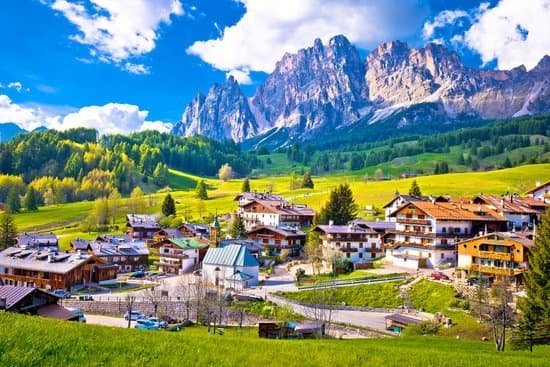Italy is a captivating travel destination that beckons adventurers from all corners of the globe. With its rich history, breathtaking landscapes, and vibrant culture, Italy has something to offer every traveler.
One of the best ways to experience the charm of this enchanting country is by embarking on city-to-city adventures, exploring the diverse wonders that each Italian city has to offer. In this article, we will delve into the travel distances between cities in Italy, uncovering the hidden gems along the way and providing tips for making the most of your journey.
Understanding Italy’s vast geographical landscape is essential when planning your travels within the country. From the towering Alps in the north to the picturesque coastlines in the south, Italy’s diverse terrain significantly impacts travel times between cities. Carefully planning your itinerary and accounting for these distances will allow you to maximize your exploration time and minimize transit periods. The strategic organization of your trip will ensure that you make unforgettable memories as you traverse this magnificent country.
When traveling from north to south in Italy, prepare yourself for lengthy distances between cities. However, these journeys are well worth it as they offer opportunities to discover iconic destinations such as Milan, Florence, Rome, Naples, and Palermo.
Along these extensive routes lie hidden gems waiting to be explored-quaint towns, stunning countryside vistas, and historical landmarks nestled amidst scenic landscapes. By taking advantage of these stops along your way, you can enrich your journey and create lasting memories beyond just visiting major cities.
Traveling from east to west across the Italian peninsula opens up a world of beauty and cultural diversity. As you venture from one coast to another, you’ll be treated to a plethora of captivating destinations such as Venice on one end and charming coastal towns like Amalfi or Cinque Terre on the other.
Each city encountered along this route brings with it unique cuisines, traditions, architectural marvels, and historical significance. Embrace the opportunity to indulge in Italy’s rich tapestry of cultures as you explore these remarkable cities.
In the upcoming sections of this article, we will delve into various modes of transportation for traversing between Italian cities. We will discuss the convenience and scenic beauty of traveling by train, the advantages of flying between cities for time-sensitive individuals, and the freedom and flexibility of embarking on a road trip.
Whether you choose to traverse Italy’s landscapes by rail, take to the skies, or hit the open road, embracing the distances between cities allows you to fully immerse yourself in everything that makes Italy an extraordinary travel destination. So join us as we embark on a journey through Italy’s enchanting cities and uncover the secrets that lie just beyond every horizon.
The Importance of Planning
Italy’s diverse geographical landscape is an essential factor to consider when planning a trip between its enchanting cities. The country’s unique shape, with its long peninsula stretching into the Mediterranean Sea, presents travelers with both opportunities and challenges in terms of travel distances. Careful itinerary planning is crucial to maximize exploration and minimize transit times while experiencing the allure of Italy.
With Italy’s vast geographical landscape, it is important for travelers to understand the considerable travel distances involved when journeying from the north to the south of the country. From iconic cities like Milan and Venice in Northern Italy to popular destinations such as Rome and Naples in Southern Italy, there are significant distances to cover. It is essential for travelers to allocate enough time for each city on their itinerary and plan their routes accordingly.
In addition to north-south travels, traversing Italy from east to west also requires careful consideration of travel distances. From the eastern coast with cities like Bari and Ancona to the western coast with destinations like Genoa and Palermo, there are diverse landscapes and picturesque towns waiting to be explored. Travelers should keep in mind that these journeys may take longer than expected due to Italy’s mountainous terrain or winding coastal roads.
To navigate between cities efficiently, Italy offers a convenient and well-connected train system. Traveling by train not only provides a scenic journey through picturesque countryside but also saves time compared to other modes of transport. With numerous high-speed trains available, traveling between major Italian cities has never been easier.
Efficient air travel is another option for time-sensitive travelers who want to explore multiple Italian cities in a short amount of time. Italy has several international airports that offer regular flights connecting major destinations within the country. Flying between cities allows travelers to cover long distances quickly, ensuring they make the most of their limited time in Italy.
For those who prefer freedom and flexibility, renting a car provides an opportunity to embark on a road trip adventure across Italy’s diverse cities. Travelers can discover hidden treasures off the beaten path and take scenic routes that showcase the breathtaking beauty of the country. However, it is important to familiarize oneself with local driving regulations and be prepared to navigate Italian roadways.
| Mode of Transport | Advantages |
|---|---|
| Train | – Convenient and efficient
|
| Airplane | – Saves transit time
|
| Rental Car | – Freedom and flexibility
|
North to South
Italy is a country known for its rich historical heritage, stunning landscapes, and vibrant cities. One of the best ways to explore Italy’s charm is by traveling between its enchanting cities. However, it is important to understand the vast distances that exist within the country in order to plan your itinerary effectively.
When journeying from the northern regions of Italy to the southern ones, travelers will discover considerable travel distances. From the iconic city of Milan in the north to the picturesque coast of Sicily in the south, there are numerous cities and regions that span this vast geographical stretch. Along this journey, there are also hidden gems waiting to be unearthed. Consider making memorable stops in cities like Florence, Rome, Naples, and Bari, each offering unique cultural experiences and historical landmarks.
On the other hand, if you wish to traverse Italy from east to west, get ready to experience the diverse cities and picturesque towns spread across the Italian Peninsula. Starting from Venice on the Adriatic coast to Genoa on the Ligurian Sea or even crossing over to Sardinia or Corsica, this excursion provides an opportunity to indulge in regional cuisines and immerse yourself in different cultural traditions.
To navigate these lengthy distances efficiently while enjoying scenic views along the way, Italy’s train system comes highly recommended. The country boasts a well-connected rail network that offers convenience and efficiency when traveling between cities. Whether you choose high-speed trains or local trains, you can admire breathtaking vistas ranging from rolling hillsides adorned with vineyards to coastal splendors of crystal-clear waters.
East to West
Italy, with its narrow and elongated shape, offers a unique opportunity for travelers to traverse the country from east to west. This section of the article will explore the distances covered when exploring Italy from the eastern coast to the western coast, showcasing the diverse cities and picturesque towns encountered along this journey.
When embarking on a cross-peninsula adventure in Italy, travelers will have the opportunity to experience the rich cultural heritage and stunning landscapes that lie between the Adriatic Sea on the east and the Tyrrhenian Sea on the west. Starting from the eastern coast, cities such as Ancona, Pescara, and Bari offer captivating historical sites and a taste of authentic Italian life.
As travelers venture further westward, they will reach iconic cities like Rome, Naples, Florence, and Pisa. Each of these cities is renowned for its unique charm, architectural wonders, and cultural treasures. Exploring these illustrious destinations allows visitors to immerse themselves in centuries of history while indulging in delectable Italian cuisine.
One cannot miss out on stopping at smaller towns dotted along this route. Picturesque coastal towns such as Sperlonga and Sorrento offer breathtaking views of cliffs plunging into azure waters. Inland gems like Perugia and Siena reveal hidden corners of Italy that boast charming cobblestone streets, medieval architecture, and vibrant local traditions.
| City | Distance (in kilometers) |
|---|---|
| Ancona | |
| Pescara | 205 |
| Bari | 424 |
| Rome | 362 |
| Naples | 228 |
| Florence | 274 |
| Pisa | 169 |
Travelers can use this table as a reference to plan their itinerary and make informed decisions about the distances they will need to cover between cities. Additionally, it may be helpful to include suggestions for modes of transportation, such as trains or car rentals, that offer efficient and enjoyable travel experiences in Italy.
Navigating the Trains
The Convenience of Italy’s Train System
When it comes to traveling between cities in Italy, one of the most popular and efficient modes of transportation is the train. Italy has a well-developed railway network that connects major cities, making it easy for travelers to navigate through the country. The convenience of train travel lies in its accessibility, frequent schedules, and fast connections.
Italy’s train system offers various classes of service to cater to different preferences and budgets. From high-speed trains like the Frecciarossa and Italo that can reach speeds up to 186 mph (300 km/h) to regional trains that traverse smaller towns and picturesque landscapes, there are options for every type of traveler. First-class compartments provide extra comfort with spacious seating and complimentary snacks, while standard class offers comfortable seats at a more affordable price.
Scenic Routes and Breathtaking Views
One of the main advantages of traveling by train in Italy is the opportunity to enjoy breathtaking views along the way. Many intercity routes are designed to showcase Italy’s stunning landscapes, passing through rolling hills, vineyards, coastal cliffs, and charming villages. From the window seat, travelers can immerse themselves in the beauty that surrounds them as they make their way from one city to another.
Some notable scenic train routes include the journey from Rome to Florence through Tuscany’s countryside, where fields of sunflowers and cypress-lined roads create a mesmerizing backdrop. Another picturesque route is the trip from Naples to Sorrento along the Amalfi Coast, offering panoramic vistas of cascading cliffs plunging into crystal-clear waters.
Tips for Train Travel in Italy
To make the most of train travel in Italy, here are some essential tips:
- Book tickets in advance: Especially during peak travel seasons or on busy routes, it’s advisable to book train tickets ahead of time. This ensures availability, preferred seating options, and sometimes even discounted fares.
- Understand timetables and connections: Familiarize yourself with train schedules to plan your journey effectively. Be aware of transfer times between trains, especially when making connections to other cities.
- Validate your ticket: Before boarding the train, remember to validate your ticket using the yellow validation machines located on platforms. Failure to do so may result in a fine.
- Pack essentials for the journey: While trains offer amenities like bathrooms and snack bars, it’s always a good idea to pack essentials such as water, snacks, entertainment, and chargers for electronic devices to ensure comfort throughout the trip.
By utilizing Italy’s efficient and scenic train system, travelers can experience seamless city-to-city travel while enjoying the picturesque landscapes that make Italy such a captivating destination. Whether embarking on a solo adventure or traveling with family and friends, hopping on a train is an excellent way to explore all that Italy has to offer.
Hopping on a Plane
Italy offers a diverse and efficient transportation system that caters to travelers with different time constraints. For those who have limited time but still want to explore multiple cities in Italy, hopping on a plane is an excellent option. Flying between cities not only saves transit time, but it also allows travelers to cover greater distances in a shorter period.
When considering air travel in Italy, there are several noteworthy airports and airlines that offer reliable connections within the country’s bustling network. Some of the major airports in Italy include Leonardo da Vinci-Fiumicino Airport in Rome, Milan Malpensa Airport, Venice Marco Polo Airport, and Naples International Airport. These airports are well-connected and serve as hubs for both domestic and international flights.
Several airlines operate within Italy, offering various flight options for travelers. Alitalia is the flag carrier of Italy and provides extensive coverage across the country. Other airlines such as Ryanair, EasyJet, and Vueling also offer affordable domestic flights within Italy.
One advantage of flying between cities in Italy is the ability to cover lengthy distances quickly. For example, instead of spending several hours on a train or driving from Rome to Venice, a direct flight can get you there in just over an hour. It allows travelers to experience more destinations within their limited timeframe.
Road Trip Exploration
Italy is a country that begs to be explored at a leisurely pace, allowing travelers to truly immerse themselves in its vibrant culture and diverse landscapes. One of the best ways to experience all that Italy has to offer is by embarking on a road trip and renting a car. This section will delve into the beauty and benefits of exploring Italy’s cities through a road trip adventure.
Freedom and Flexibility
Renting a car in Italy grants travelers the freedom and flexibility to chart their own course and discover hidden gems off the beaten path. Unlike other modes of transportation, such as trains or planes, renting a car allows you to tailor your journey according to your interests and preferences.
Whether you want to detour to charming hilltop villages, explore picturesque countryside landscapes, or make spontaneous stops along the way, having a car at your disposal gives you the control to create an itinerary that suits your travel style.
Scenic Routes and Hidden Treasures
Driving through Italy unveils breathtaking scenic routes that highlight the country’s natural beauty. From winding coastlines with azure blue waters to rolling vineyards surrounded by picturesque hills, each stretch of road offers panoramic vistas that are best enjoyed at your own pace.
Additionally, renting a car opens up opportunities to visit lesser-known destinations that may not have efficient public transportation options. These hidden treasures could include quaint coastal towns, tucked-away wineries, or charming medieval villages perched high on cliffs.
Tips for Renting a Car in Italy
When planning a road trip in Italy, it is essential to be prepared and well-informed about local driving regulations and practicalities. Here are some tips for renting a car and navigating Italian roadways:
- Research Rental Companies: Compare prices and reviews from different rental companies before making your reservation. Consider factors such as insurance coverage, vehicle options, pickup locations, and customer service ratings.
- International Driving Permit: Obtain an International Driving Permit (IDP) before arriving in Italy. This document, along with your valid driver’s license, is required to drive legally in the country.
- ZTL Zones: Familiarize yourself with Limited Traffic Zones (ZTL) in Italian cities. These restricted areas are often inaccessible to non-residents and come with heavy fines if violated.
- Parking: Research parking options for each destination ahead of time. Many cities have designated parking garages or lots that require pre-booking, especially in popular tourist areas.
- GPS Navigation: Invest in a reliable GPS navigation system or use offline maps on your smartphone to help you navigate through Italy’s intricate road network effectively.
Taking the wheel and embarking on a road trip adventure through Italy allows travelers to immerse themselves in the rhythms of this mesmerizing country. By renting a car, you can explore at your own pace, uncover hidden treasures, and create unforgettable memories as you traverse from one enchanting city to another. So buckle up and get ready to embrace all that Italy has to offer as you embark on an incredible journey of discovery.
Final Thoughts
In conclusion, exploring the enchanting cities of Italy through travel distances is a truly remarkable experience. The vast geographical landscape of Italy offers a diverse range of destinations, each with its own unique charm and allure. Careful planning is essential to make the most of your trip, as understanding the distances between cities is crucial in creating an efficient itinerary that maximizes exploration while minimizing transit times.
Whether you choose to journey from north to south or traverse the Italian peninsula from east to west, there are countless hidden gems waiting to be discovered along the way. From iconic cities to picturesque towns, Italy’s diverse landscapes offer something for every traveler. Indulging in the local cuisines, immersing oneself in cultural traditions, and visiting historical landmarks are all part of the journey when traversing between cities.
When it comes to transportation within Italy, the train system proves to be both convenient and efficient. Not only does it allow you to navigate seamlessly between cities, but it also offers breathtaking views during intercity journeys. However, for those with limited time and a desire to cover greater distances, flying between cities can be a viable option. Italy’s well-connected airports provide reliable connections and save valuable transit time.
For those seeking freedom and flexibility, embarking on a road trip is an excellent choice. Renting a car allows you to explore off-the-beaten-path destinations and discover hidden treasures that may not be easily accessible by other means of transport. It provides an opportunity to experience the rhythms of Italy firsthand while adhering to local driving regulations and appreciating the country’s scenic roadways.
In essence, embracing Italy’s travel distances opens up a world of possibilities for adventurous travelers. By appreciating not only the destination but also the journey itself, one can fully immerse themselves in Italy’s rich landscapes and cultural tapestry. So why wait? It’s time to embark on your own adventure and discover the extraordinary cities that make Italy a timeless travel destination. You won’t be disappointed.
Frequently Asked Questions
How far are Italy cities from each other?
The distance between cities in Italy can vary significantly depending on which cities you are referring to. For example, Florence and Rome are approximately 180 miles apart, while Venice and Milan are around 170 miles away from each other.
However, Italy is a relatively small country compared to some others, so most cities are within a manageable travel distance from each other. To get a better idea of the exact distances between specific cities, it’s best to refer to a map or use online resources that provide accurate measurements.
What is the best way to travel to multiple cities in Italy?
The best way to travel to multiple cities in Italy largely depends on your preferences and priorities. One popular option is by train, as Italy has an extensive and efficient rail network connecting major cities and picturesque towns throughout the country. Trains offer convenience, speed, and the opportunity to enjoy scenic views along the journey.
Alternatively, domestic flights can be a time-saving choice for covering longer distances or crossing the country quickly. Renting a car also provides flexibility and allows you to explore off-the-beaten-path destinations at your own pace, though traffic congestion and limited parking in some city centers can be challenges.
How many miles is it from top to bottom of Italy?
From top to bottom, Italy measures roughly 800 miles in length, excluding its islands such as Sicily and Sardinia. Starting from the northern border with Switzerland at the foot of the Alps near Aosta Valley down to the southernmost tip of mainland Italy in Calabria, this distance encompasses diverse landscapes and regions that offer unique experiences for travelers.
This vertical dimension allows visitors to explore various climates ranging from Alpine peaks in the north to Mediterranean coastlines in the south, giving them an opportunity to witness different cultural traditions and natural wonders along their journey throughout Italy.

I’m a passionate traveler, writer, and Italophile. My fascination with Italy’s history, art, and culture has led me on countless adventures across the Italian landscape. Through “I Live Italy,” I share my love for this extraordinary country and aims to inspire others to explore its boundless beauty.





